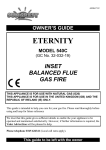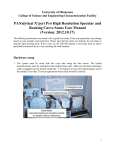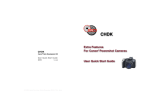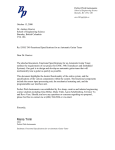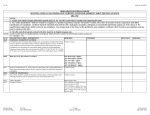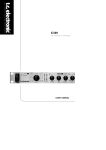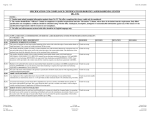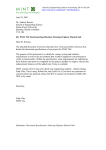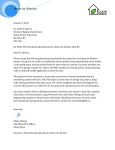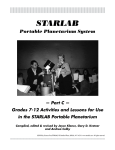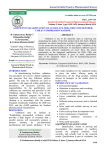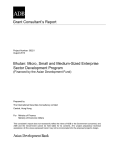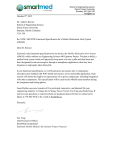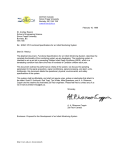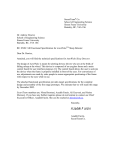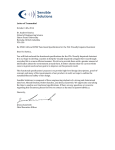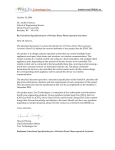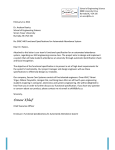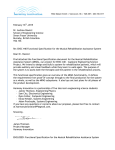Download Feb 07, 2015 Dr. Andrew Rawicz School of Engineering Science
Transcript
Functional Specification for the Stellar Dish Sun-tracking Solar Cooker Feb 07, 2015 Dr. Andrew Rawicz School of Engineering Science Simon Fraser University Burnaby, British Columbia V5A 1S6 RE: ENSC 440 Capstone Project Functional Specification (FS) for the Stellar Dish Sun-tracking Solar Cooker Attached is the functional specification for the Stellar Dish Sun tracking Solar Cooker. We intend to design and build a working Solar Cooker with an integrated sun tracking mechanism to harness 25% more solar power than a manual sun cooker [1]. The functional specification will contain a detailed description of the system overview, user interaction, component/material selection, electrical, mechanical and power requirements, performance requirements. Every component of our product is entailed with safety and engineering standard requirements associated with it. “Approximately 1.5 million die per year from respiratory diseases related to smoke inhalation, which are mostly children and women” [2]. Using SunCrest's solar cooker will not emit toxic fumes or smoke which will alleviate the respiratory diseases. Another major problem pertaining to using firewood to cook is the risk of cataracts or cancer as a result of long time exposure to EMR. Tenzin, one of our team member said, “My grandmother actually had cataracts in her eyes for three years, which blinded her for three years”. SunCrest Inc. comprises of three dedicated and fully-committed 4th-year engineering students: Owen Au, Tenzin Sherpa and Imtiaz Charania. We are all motivated to design and deliver the best possible product to our clients and believe in turning idealities into reality one step at a time. Please feel free to contact at [email protected] Sincerely, Owen Au CEO, SunCrest Inc. Copyright © 2015, SunCrest Inc. Functional Specification for the Stellar Dish Sun-tracking Solar Cooker Project Team: Phur Tenzin Sherpa Owen Au Imtiaz Charania Contact person : [email protected] Copyright © 2015, SunCrest Inc. Submitted to: Dr. Andrew Rawicz-ENSC 440 Steve Whitmore-ENSC 305 School of Engineering Science Simon Fraser University Issued Date: Revision: Feb 18, 2015 2.0 Functional Specification for the Stellar Dish Sun-tracking Solar Cooker Executive Summary Cooking is a fundamental part of everyday life. Many developing countries do not have access to modern heat sources and are still cooking with firewood and cow dung. We propose to alleviate this problem by harnessing the solar power to cook food. The concept of solar cooking has existed since the time of Archimedes [1]. However, existing solar cooker designs are expensive, use relatively inaccessible materials such as fiber glass, weigh as much as 4.5kgs and require periodic repositioning throughout the day to maximize the solar power [3]. The current manual parabolic solar cookers such as the one from One Earth Designs retails for about 400 dollars US. Using light materials for our parabolic dish, we will design a solar cooker that costs under $300 equipped with a versatile sun tracking system. We have divided the development of our solar powered cooker into three different phases. Phase 1: Main azimuthal sun tracking mechanism (East to West) Since the sun follows a circular trajectory revolving around the earth from east to west, the stellar dish rotates in the same direction. In order to keep up with the rotating sun, the dish should rotate constantly with an angular velocity of 2.5º every 10 minutes. Considering that the zenith elevation angle between the sun and the ground is different depending on location (away from the equator), the user is required to input the current location using the product interface. A secondary rotating mechanism will facilitate this zenith angle adjustment. Phase 2: Secondary sun tracking mechanism (North to South) Tracking the sun from north to south only slightly improves the efficiency of the solar cooker because the earth only moves 46 degrees from north to south every year. If a north-to-south sun tracking feature incurs more costs than added benefits, it will not be implemented. Phase 3: LDR sun tracking system based on intensity comparison The final phase requires the implementation of an LDR-based feedback control system for the automated tracking mechanism. This method of sun tracking consisting of light sensitive LDRs is expected to be the best way to track the sun on a clear sunny day. The primary feedback control system compares the intensity/voltage measured between two adjacent sides of the dish and adjusts the dish to minimize the difference. However, if the total measured intensity/voltage happened to be less than 70% of sun’s intensity, the rotation will occur via time controlled mechanism as discussed in phase 1. Copyright © 2015, SunCrest Inc. II Functional Specification for the Stellar Dish Sun-tracking Solar Cooker Table of Contents Executive Summary ..................................................................................................................................... II List of Figures ............................................................................................................................................. IV Glossary ...................................................................................................................................................... IV 1 INTRODUCTION ................................................................................................................................... 1 1.1 Scope ................................................................................................................................................... 1 1.2 Intended Audience .............................................................................................................................. 1 1.3 Classification....................................................................................................................................... 1 2 SYSTEM REQUIREMENTS .................................................................................................................... 2 2.1 System Overview ................................................................................................................................ 2 2.2 General requirements .......................................................................................................................... 2 2.3 Physical requirements ......................................................................................................................... 3 2.4 Electrical requirements ....................................................................................................................... 3 2.5 Mechanical Requirements ................................................................................................................... 3 2.6 Safety requirements ............................................................................................................................ 3 2.7 Standards requirements ....................................................................................................................... 3 2.8 Performance requirements .................................................................................................................. 4 3 SUPPORT STRUCTURE REQUIREMENTS .......................................................................................... 4 3.1 Description .......................................................................................................................................... 4 3.2 General Requirements ......................................................................................................................... 4 3.3 Physical Requirements ........................................................................................................................ 4 3.4 Environmental Requirement ............................................................................................................... 5 3.5 Safety Requirement ............................................................................................................................. 5 4 MICROCONTROLLER/CIRCUITRY REQUIREMENTS ...................................................................... 5 4.1 Description .......................................................................................................................................... 5 4.2 Power/Electrical Requirements ........................................................................................................... 5 5 SOFTWARE REQUIREMENT ................................................................................................................ 6 5.1 Description .......................................................................................................................................... 6 5.2 General Requirements ......................................................................................................................... 6 6. USER MANUAL REQUIREMENTS ...................................................................................................... 6 6.1 General Requirements ............................................................................................................................. 6 7 SYSTEM TEST PLAN .............................................................................................................................. 6 7.1 Mechanical Rotational System Test Plan............................................................................................ 6 7.2 Battery Test Plan ................................................................................................................................. 7 7.3 LDR Electronic Circuit Test Plan ....................................................................................................... 7 7.4 Microcontroller Test Plan ................................................................................................................... 7 7.5 Support Structure Load Stress Test Plan............................................................................................. 7 7.6 Overall Performance Test Plan ........................................................................................................... 7 8 CONCLUSION .......................................................................................................................................... 8 9 BIBILIOGRAPHY .................................................................................................................................... 8 Copyright © 2015, SunCrest Inc. Functional Specification for the Stellar Dish Sun-tracking Solar Cooker List of Figures Figure 1 High Level Diagram Glossary Azimuthal angle Horizontal angle measured clockwise starting from the North Zenith angle Vertical elevation angle LDR Light-Dependent Resistant ASAE American Society of Agricultural Engineers ANSI American National Standards Institute Copyright © 2015, SunCrest Inc. IV Functional Specification for the Stellar Dish Sun-tracking Solar Cooker 1 INTRODUCTION The Stellar Dish Sun Tracking Solar Cooker is a parabolic solar cooker with sun tracking capabilities and is designed to be low-cost, affordable and efficient. The apparatus can achieve cooking temperatures of approximately 250°C on a typical sunny day at places closer to the equator. The Stellar dish is equipped with a LDR - dependent sun tracking mechanism which allows the dish to locate the sun and adjust its position to provide maximum efficiency. On a cloudy day, the product will promptly switch from LDR sun tracking to sun tracking based on time. To facilitate the tracking motion, the parabolic dish is mounted on a turntable zenith angle rotated by an Arduino-controlled stepper motor. 1.1 Scope This document contains detailed functional requirements of the Stellar dish. These requirements explain the proof of concept model and also describes the production necessities for this device. The engineers at SunCrest Inc. will strictly follow these design and construction guidelines keeping safety as a first priority. This document will drive the future design of the system and our engineers will strictly make sure all of the stated requirements are considered and met in all of the developmental stages of our product. 1.2 Intended Audience This functional specification document is intended to be used by the members of SunCrest Inc. and as a reference for legal disputes. The project supervisor will use this document to track various phase completions. Test engineers may also use this specification as a guide to verify functionalities of the product. 1.3 Classification The following syntax will be used in this document to state functional requirements: [Rn-p] n: p: A functional requirement representation Functional requirement number. Priority of the functional requirement. p can has the following values and their respective explanation. I: II: III: The requirement applies to the proof of concept system only. The requirement applies to both, the proof of conceptual system and the final production system. The requirement applies to the final production system only. 1 Functional Specification for the Stellar Dish Sun-tracking Solar Cooker 2 SYSTEM REQUIREMENTS 2.1 System Overview The system design consists of 5 components: LDR circuitry, user interface, microcontroller, rotating mechanism and a stable support structure. The user must input the time of day and location so that the solar dish can approximate the sun’s location to initialize the system. If the weather permits, the solar dish will rely on the LDR system to fine tune its optimal position and collect maximum sunlight. Both the sunlight intensity information from the LDR circuitry and user input will be forwarded to the microcontroller to calculate the angular velocity according to the location. The microcontroller will send a signal to the stepper motor aligning the dish with the sun for maximum efficiency. Figure 1. High Level Diagram 2.2 General requirements [R1-I] [R2-II] [R3-II] [R4-II] [R5-II] The price should be under $300 The parabolic cooker should be durable against wind and waterproof The entire arrangement should be easy to setup in less than 20 minutes The cooker will have an ON/OFF switch The design will automatically useLDR sun tracking or time sun tracking depending on weather 2 Functional Specification for the Stellar Dish Sun-tracking Solar Cooker 2.3 Physical requirements [R6-I] [R7-I] [R8-I] The dimension of the entire product should be no bigger than 1m x 1m The overall weight should be no heavier than 8 lbs. The height of the parabolic dish should be no higher than 4 ft. 2.4 Electrical requirements [R9-I] [R10-I] [R11-II] The portable power supply should be able to last 4 hours The stepper motor should provide 5 N.m Torque The power supply should be able to connected to a standard Battery outlet 2.5 Mechanical Requirements [R12-I] [R13-I] [R14-I] [R15-I] Light and strong materials/ plywood The turntable should have rotation range of at least 180 degrees Torque provided should rotate the gear and the turntable. Our umbrella dish should turn 2.5 degrees every ten minutes azimuthally 2.6 Safety requirements [R16-II] [R17-II] [R18-II] Reflectors should be installed to reflect away harm sun rays from the user The cooking temperature of the solar cooker will NOT drop to temperatures between 52 celsius and 10 celsius for longer than 30 minutes during which bacteria may spoil the food being cooked [3]. The design of the dish shall be low enough to not cause eye damage to the user 2.7 Standards requirements [R19-II] [R20-II] The design test procedures will conform to the ASAE and therefore ANSI standards All connection configurations must conform to the CSA Canadian Electrical Code 3 Functional Specification for the Stellar Dish Sun-tracking Solar Cooker 2.8 Performance requirements [R21-I] [R22-I] [R23-I] [R24-I] [R25-I] [R26-II] The dish should follow the sun with an accuracy loss of at most 1 degree The cooking temperature should be reach up to 250 degrees The power output of the solar cooker should reach up to 1500W on a sunny day Typical foods should be fully cooked in 30 minutes The parabolic dish will adjust to the correct zenith angle to face the sun relative to location automatically The parabolic dish will rotate azimuthally by means of a turntable to track the sun [6] 3 SUPPORT STRUCTURE REQUIREMENTS 3.1 Description It is very important for the structure to be statically stable that is the structure should be in equilibrium when various external forces act upon the system. Since the system is designed to be used outdoors, it should be able to withstand natural forces such as wind, rain and the weight of cooking apparatus that may exert on the system. 3.2 General Requirements [R27-II] [R28-II] [R29-II] [R30-II] [R31-II] The pot stand will be metallic rigid hollow cylinder of height of 1 m and diameter of 0.7 cm A plastic insulating hollow tube will be placed inside the metallic cylinder The wires connecting Arduino to the motor will be encapsulated in the metal hollow cylinder for environmental protection (rain) The pot base will be black metal to capture more heat The pot stand will support up to 5 kilograms of weight 3.3 Physical Requirements [R32-II] [R33-II] [R34-II] [R35-II] The turntable/plywood will be placed on a smooth rotating surface The cylinder will be able to withstand the weight exerted by the food/apparatus that needs to be heated The cylinder will be placed at a distance such that most of the heat reaches at the focal point of the dish The gear will be mounted such that the motion of the motor is transferred safely and efficiently to the turntable 4 Functional Specification for the Stellar Dish Sun-tracking Solar Cooker 3.4 Environmental Requirement [R36-II] [R37-II] [R38-II] The metallic cylinder will be able to withstand natural forces such as wind, rain, snow, shaky ground and others The mounted dish on the turntable will be able to withstand natural forces as well A drainage system will be implemented on the turntable in order to avoid excessive load on the motors incase water/ snow stays on the turntable 3.5 Safety Requirement [R39-II] [R40-II] All the joints/soldering/drilling will be concealed from the user to avoid physical damage to the user and the equipment. Extra room will be left inside the cylinder in order to avoid touching the rotating gear and circuitry. 4 MICROCONTROLLER/CIRCUITRY REQUIREMENTS 4.1 Description The microcontroller is the key element to implement the Sun tracking mechanism. The differences in the measured intensities are fed into the microcontroller which is then processed to calculate the sun’s position to maximize efficiency. 4.2 Power/Electrical Requirements [R41-II] [R42-II] [R43-II] [R44-II] [R45-II] [R46-II] Power from the solar cell into the Arduino should be 9V-12V Anytime the power supplied to the Arduino is less than 9V the backup battery power should be activated The micro-controller and the circuitry should be packed in a black box, so it is safe from rain/wind The wires connecting the servo and the Arduino should be durable and rain protective Key voltage nodes shall be easily accessible for measurement, troubleshooting and debugging. When the LDR resistors senses less than 70% of light than the umbrella dish will use a timed-rotation device to rotate 5 Functional Specification for the Stellar Dish Sun-tracking Solar Cooker 5 SOFTWARE REQUIREMENT 5.1 Description Once the intensities are measured using LDRs, they are converted into voltages and the software interprets if the motor should be running as a consequence of the difference in voltages. Our program loaded on the Arduino chip will regulate the current to the motor in-order to determine the rotation required. 5.2 General Requirements [R47-II] [R48-II] [R49-II] [R50-II] [R51-II] The software will calculate the difference between two voltages and determine the sun’s position The software will regulate current to the motor in order to face the dish towards the sun. A timer will be turned on by the software when there is not enough sunlight present throughout the day i.e. cloudy weather. Timer will set the motor to rotate at an angular velocity of 15 degrees/hour If time permits, there will be a temperature sensor placed at the cylinder in order to get the temperature and safety regulations. 6. USER MANUAL REQUIREMENTS 6.1 General Requirements [R52-III] [R53-III] [R54-III] The user manual must inform the user on the proper operation of the solar cooker to ensure maximum safety The user manual must specify all possible safety precautions The user manual must be easy to follow including detailed schematics. 7 SYSTEM TEST PLAN 7.1 Mechanical Rotational System Test Plan The stepper motor should provide enough torque and angular acceleration such that the motion transfers to the turntable, rotating the dish at 2.5° every 10 minutes without fracturing the screws/nuts/bolts holding the system together. To ensure the turntable rotates at 2.5° every 10 minutes, we will incorporate a tachometer or a gyroscope to monitor the angular speed. For safety, the design will also be tested after adding moisture/dampening to the turntable to account for climatic changes. 6 Functional Specification for the Stellar Dish Sun-tracking Solar Cooker 7.2 Battery Test Plan When there is no access to an electrical outlet, rechargeable batteries will be the power source. A multimeter will be used to test the backup batteries to see if the voltage reaches the intended voltage rating. 7.3 LDR Electronic Circuit Test Plan The umbrella will be ringed with LDRs around it. This test plan will involve measurements of the light intensity difference between the set of LDRs. If these differences are significant then it will correspond to a rotation of a certain degree. Rotation as a function of LDR differences will be decided based on physical feasibilities. Theoretically, if the dish is perfectly adjusted, the LDR differences should be negligible. Using ambient light sensors compatible with arduino, tests will be done to check if this is indeed the case. We will extract these analog voltage outputs to test if the design is performing up to standard. 7.4 Microcontroller Test Plan The analog differences calculated by the Microcontroller will be converted into voltage either by implementing ambient light sensors or designing a circuit of our own. At the same time, a digital voltmeter will be connected to the LDR’s in order to confirm if the voltages are equal, i.e. the Microcontroller is working as intended. 7.5 Support Structure Load Stress Test Plan The structure will be strong enough to retain food and other apparatus placed on top of the cylinder. It will also be tested against horizontal forces in order to avoid slipping and tripping under extreme weather conditions. 7.6 Overall Performance Test Plan Our final design will be subjected to the standards of ASAE Solar Cooker Performance Test1. The test will involve determining the cooking power from boiling water which is a measurement of quality devised by ASAE in different weather environments by consistently recording the average water temperature of the cooking vessel, solar insolation, wind speeds, and ambient temperatures. We may also perform a Controlled Cooking Test (CCT) [4] to gauge stove performance in a controlled environment and a Kitchen Performance Test (KPT) [5] to gauge stove performance under real-world settings if time permits and is deemed necessary. 7 Functional Specification for the Stellar Dish Sun-tracking Solar Cooker 8 CONCLUSION This document has outlined all the functional and safety requirements of a Sun tracking solar cooking system. SunCrest Inc. believes that this solar cooking system is more efficient, safe, and cheap and saves time by eliminating the need to move the solar dish with respect to the suns revolution throughout the day. The functional specifications provided in this document ensures that the system is safe, efficient, time-efficient and follows CSA and ASAE standards and regulations. Additional features might be added to this design if these functional/safety requirements are met ahead of completion date which is set for early April 2015. 9 REFERENCES [1] Solar tracker. (n.d.). Retrieved February 17, 2015, from http://en.wikipedia.org/wiki/Solar_tracker [2] Rehfuess, E. (2006). Fuel for life: Household energy and health (p. 4). Geneva: World Health Organization. [3] Satellite dish. (n.d.). Retrieved February 14, 2015, from http://solarcooking.wikia.com/wiki/Satellite_dish [4] Bailis, R. (2004, August 1). Controlled Cooking Test (CCT). Retrieved February 17, 2015, from http://www.pciaonline.org/files/CCT_Version_2.0_0.pdf [5] Bailis, R. (2007, January 1). Kitchen Performance Test (KPT). Retrieved February 10, 2015, from http://www.pciaonline.org/files/KPT_Version_3.0_0.pdf. [6] Testing and Reporting Solar Cooker Performance. (2003, January 1). Retrieved February 15, 2015, from http://solarcooking.org/asae_test_std.pdf 8













